«previous pageRESIDENTIAL DESIGN CATEGORY
Honor Award
Vienna Way Residence, Venice, CA
Marmol Radziner & Associates, Los Angeles, CA
client: Ron Radziner and Robin Cottle
Project Statement
The design of the Vienna Way landscape fully integrates the residence within the surrounding California native landscape. The architecture and landscape were designed to work in unison, creating a seamless transition between the interior and exterior living spaces. The element of water links a “corridor” of exterior spaces—swimming pool, garden roof, riparian planting — and intersects with the interior spaces at the sunken kitchen.
Project Narrative
The Vienna Way site is divided into thirds with the architecture massed at the outer edges and the garden spaces in the middle. This spatial organization maximizes the amount of physical and visual open space within a narrow, urban lot.
The exterior spaces are divided into thirds as well by the water “corridor” that literally begins with the swimming pool and is implied by the repeated, mass plantings of Chrondopetalum tectorum (Cape Rush) — a plant naturally found at water edges — which align with the pool and kitchen window in the front garden, continue to the garden roof over the sunken kitchen, and culminate at the rear garden with three California Sycamores. Flanking this riparian “corridor” are drought-tolerant plantings reminiscent of a Chaparral landscape including Quercus agrifolia (Coastal Live Oak), Quercus lobata (Valley Oak), native Muhlenbergia rigens (Deer Grass) and Rhus lancea (African Sumac)
The front garden is designed to be an adult, more mature space with simple, monochromatic, architectural plantings, while the rear garden becomes a place for children’s play. The backyard planting design, which includes a lawn of Buffalo Grass, is more colorful, varied and organically arranged than the front garden. It includes California natives Salvia apiana (White sage), Salvia clevelandii (Cleveland Sage) and Fremontodendron californica (Flannel Bush) as well as a raised vegetable planter.
Due to the large quantity of native California plants and desired size at installation, many were “contract grown” by two local nurseries. All of the trees were field grown and craned into the site. Despite the fact that the organizing element for the garden is water, the plants by and large are drought-tolerant.
Project Resources
Lead Designer
Ron Radziner, FAIA, Affiliate ASLA
Landscape Architect
Meg Rushing Coffee, ASLA
Featured Products
Specimen Coast Oak Trees
Valley Crest Tree Company
Specimen Valley Oak Trees
Berylwood Tree Farm, Somis, CA
Specimen Sycamore Trees
Baron Brothers Nursery
Native Plants
Contract-grown by El Nativo Growers
Native Plants
Contract-grown by Tree of Life Nursery
Garden Roof Assembly
American Hydrotech, Inc.
Landscape Lighting
B-K Lighting
Irrigation Controller
Superior Controls Co., Inc.
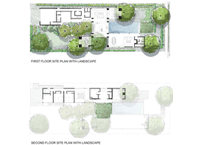
First and second floor site plan with landscape
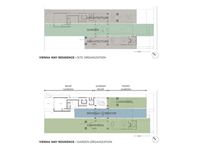
Vienna Way Residence: top: site organization; bottom: garden organization
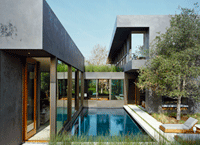
The central “corridor” created by the swimming pool, garden roof and mass plantings of Cape Rush clearly communicate the spatial organization of the site. Interior and exterior intersect at the sunken kitchen. (Photo: Joe Fletcher)
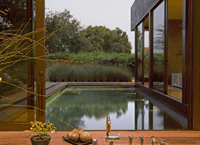
View from the sunken kitchen looking across to a mass planting of Cape Rush and screening hedge of African Sumac. The African Sumac completely obscures the street and encloses the front garden creating a feeling of refuge and privacy. (Photo: Steve Gunther)
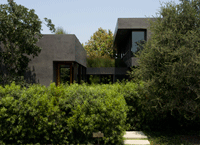
Pool and garden are completely hidden from the street by an informal hedge of African Sumac. (Photo: Jack Coyier)
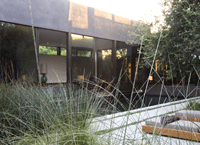
A mass of native California Deer Grass and a specimen Coast Live Oak flank the swimming pool. (Photo: Steve Gunther)
"The landscape architect shows such a confident hand in this project. The ideas follow the modular forms of the house. The front elevation is so beautiful with the sumac against the black plaster. It represents very clear thinking about landscape architecture."
— 2009 Professional Awards Jury
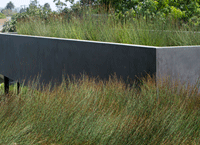
The garden room is planted with Cape Rush and is visible from the second story hallway and bedrooms. The approximately eight inches to soil help to regulate the temperature of the kitchen below, reducing the need for air conditioning and heating. (Photo: Jack Coyier)
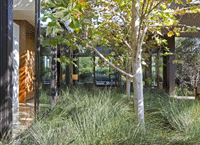
The riparian corridor ends in the rear garden with three California Sycamores that provide shade to the upper story. (Photo: Joe Fletcher, Steve Gunther, Jack Coyier)
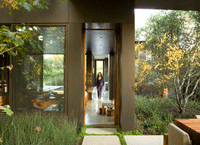
The kitchen opens onto an outdoor dining area and side garden with multi-trunked Coast Live Oak and native California understory planting of Catalina Perfume. (Photo: Joe Fletcher, Steve Gunther, Jack Coyier)
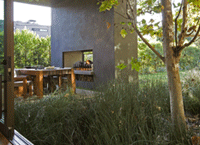
View of outdoor dining area in rear garden. (Photo: Joe Fletcher, Steve Gunther, Jack Coyier)
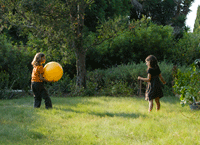
The rear garden Buffalo grass lawn is a place for play. (Photo: Joe Fletcher, Steve Gunther, Jack Coyier)



